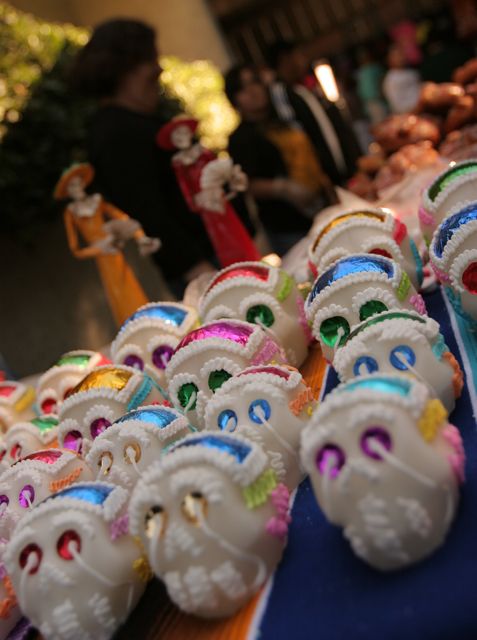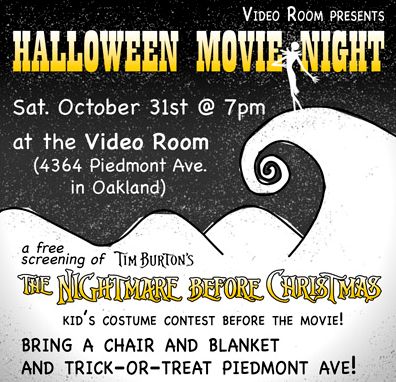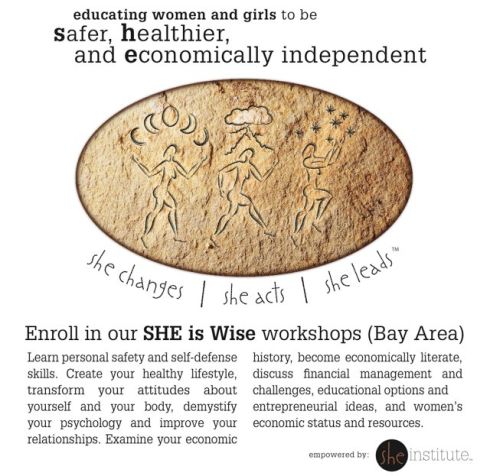You are currently browsing the monthly archive for October 2009.
It is autumn in the Glenview. Dried sycamore leaves collect at the foot of red cement stairwells and crack underfoot. Spiders have spun webs all over yards up and down Park Boulevard, almost as thick as the store-bought cobwebs I see clinging to hedges next to dummy witches. The summer warmth makes its exit in fits and starts as the crisp air settles in. The holiday season, a marathon of sugar binges and punched-up cider, begins with Halloween this weekend. Here’s what Oakland has in store:
In the Glenview: Tomorrow on All Hallows Eve, Glenview Elementary will host its annual block party from 11 a.m.–2 p.m., on Tiffin Road. Bring a dish to share and meet the neighbors. Take part in the food, games and in making a financial pledge to the school; costumes, like donations, are encouraged but not required. Later on that evening on Greenwood Avenue, a spooky puppet show and yard haunt is rumored to start at nightfall. Glenfriend John has created a Flickr group so Oaklanders can share their photos of the festivities.
In West Oakland: Also for Halloween, check out “FrankenSk8,” an event held in Town Park. It’s Oakland’s premiere skating venue brought to you by Hood Games, a community grown out of East Oakland. They successfully convinced the city to carve out a space in deFremery Park for skaters to work on their skills and officially opened in July. Bring your board or simply scope the local talent from 12 p.m.–3 p.m.
On Piedmont Avenue: This neighborhood will be all things Samhain from dawn ’til dusk. The merchants association will throw its 23rd Annual Piedmont Avenue Halloween Celebration from 9:45 a.m., when patrons can see free cartoons at the Landmark Theatre. After the parade and a trick-or-treat at Issues, visit Mountain View Cemetery. It rests at the top of Piedmont Avenue and hosts a pumpkin festival, where kids can count on a free pumpkin, treat bag and plenty of time in the jump house.
Closing out the evening is a free screening of “Nightmare Before Christmas” at the Video Room. The film runs in the yet-to-rented storefront beside the store’s current location. Prizes go to the best kids costume:
Downtown: For the cocktail crowd, The Den serves up a “Thrillerthon” costume ball this Halloween. Give-away treats at the Halloween bash range from dinner certificates at local restaurants to free drinks at future Den parties. DJ Epic and DJ Mpenzi will spin in honor of Haitian Gede and Michael Jackson’s “Thriller,” explaining one of the costume contest categories: Best MJ Look-alike. Also performing is the Kendra Kimbrough Ensemble and the El Wah Movement Caribbean Dancers. Doors open at 8:30 p.m. with tickets at $5 before 10 p.m. and $10 thereafter.
Dia de los Muertos in The Fruitvale: Oakland’s best festival is arguably Dia de los Muertos. In past years its attendance has surpassed many Dia de los Muertos celebrations across the country. This year, it was almost in danger of dying out but was resurrected in time for Sunday, November 1, thanks in part to Oakland’s Vice Mayor Ignacio De La Fuente. Every year on International Boulevard, the entire Fruitvale skyline transforms with rainbow-colored paper prayer flags. Sugar skulls and sweet pan de muertos pile high. But front-and-center for food concessions are from La Borinqueña Restaurant & Specialty Shop in Old Oakland; Tina “Tamale” Ramos represents with family recipes going back for generations—hopefully with some of their tasty green chile and cheese tamales.
This year more than 25 altars spill out onto the street from the ‘Vale Transit Village. A portion of them are provided by the Oakland Museum, which is currently closed for renovations. Still, they make an appearance at the festival with an interactive display and make a virtual ofrendas online. The dead fest begins at 10 a.m. with music from local Latino bands, cultural crafts and games, and shutters at 5 p.m. To get there, you could take the bus or BART to the Fruitvale station. From the escalator, follow the scent of marigolds and you’ve arrived.
Mas Muertos: Many peoples observe the dead with rituals. The Haitians, Celts and Native Americans each had their method of reaching for loved ones in the Otherworld. There’s also curious overlap across cultures. The Greeks spoke of Persephone presiding over the dead, and ushering departed souls to their new residences. The Aztecs, for their part, personified this “Lady of the Dead” as the goddess Mictecacihuatl. According to the story, she dies in childbirth the Underworld, where she and her husband Mictlan watch over the bones of those passed. This ensures that the lifeless bones could, if needed, build a people for some future world.
The Oakland Museum has online resources on the Day of the Dead that’s worth a peek. Under the Bay Area events is a healthy book list, featuring the indispensable “Digging the Days of the Dead,” by Juanita Garciagodoy. She writes somewhat academically but lucidly about the origins of the rites and looks at death as viewed today. It’s a great read for information and the index contains poems like the one by an ancient American poet, Cuahcuauhtzin:
My heart longs for flowers anxiously.
I only suffer with songs,
I only essay my songs,
on the earth, I am Cuahcuauhtzin.
With anxiety I want flowers,
may they rest in my hand,
I am wretched!
Where will we go
that we may never die?
Although I were jade,
although I were gold,
I will be melted, I will be perforated
in the crucible.
My heart, I Cuahcuauhtzin,
am a wretched man!
In her chapter “The Lively Skeletons,” Garciagodoy examines the oxymoronic nature of the Mexican holiday. She writes, “The calaveras are working, self-reflexively making offerings to the dead, socializing, or displaying themselves. Whatever they are doing, what may be most obvious about these skeletons is that they are not dead.” Skulls shrouded in vibrant colors walk a line between life and death. They do not dwell on last rites but on timeless rituals. In this realm, life seems the most brilliant.
One could make a similar argument for Oakland: it may be haunted by wayward ghosts, but it’s on the cusp of renewal. The city lets out its closeted skeletons every fall and takes stock of the living and the dead. A dark subject and bright colors show the beauty of life in stark contrast. And fittingly, Oakland shines.
Today Bobby Seale turns 73 years old. A week before his 30th birthday, he co-founded the Black Panther Party with Huey Newton steps away from their North Oakland community college. Seale spoke to a small crowd some ten years ago at the now closed New College of California; he had the same furrowed brow and mustache pictured in archival photos, but sported a pair of suspenders and silvered hair. He engaged the audience with his boisterous energy as he talked about past political rallies. His memoir, “Seize the Time,” remains the most popular book about the Black Panthers, a revolutionary group that changed the consciousness of a nation.
You can check out a host of BPP literature today and tomorrow at Laney College, from 11–3 p.m. Former Panthers turned authors will present a book fair at the Student Center. It’s just one of several events dedicated to October, aka Black Panther Party History Month:
Billy “X” Jennings has called Seale’s autobiography the “Bible of the Black Panthers.” A former Panther and party archivist, Jennings is co-hosting the event with The Commemoration Committee of the Black Panther Party, run by Melvin Dickson. Dickson was one of the Panthers to start the Community School—a place where kids could get a free meal, school supplies, access to medical care and bus fare.
With 43 years between now and the moment Seale and Newton laid down the party’s constitution, time has mitigated much of the Panthers’ history. Memories and mainstream media accounts of the Panthers conflict and conflate with one another. It’s a story defined by its diversity and best understood in volume.
Certainly, the books written by and about the Black Panther Party could fill a library. A couple of them can be found here. Stay tuned for a more complete list.
Lately crime has taken a toll in my neighborhood. Within the last two weeks, my friend got held up at gunpoint on 13th Avenue, and a couple guys walked up my driveway and broke into my car. I’m not sure what I’d have done if I ran into the thieves before they stole my stereo. When I was in high school and a guy pulled a knife on me, all I could do was run.
Next time I feel threatened though, I want to kick criminal ass—just like the femi–ninjas I used to watch on TV in the ’70s. To do this, I’ll need a mentor to teach me street fighting in real life.
Enter Helen Grieco. She’s the daughter of a marine and a 25-year of veteran N.O.W. She believes in “the sovereign right of women to defend themselves by any means necessary.” And her self-defense training course begins next week, in Oakland.
Grieco certainly has a lot of fight in her. Her story of survival spans from New York to California, and over decades of domestic abuse, drug addiction, eating disorders and dysfunctional relationships. But one day on a San Francisco doorstep, she saw a glimmer of hope.
“I was in the midst of an abusive relationship,” she said, “and only had a few dollars to my name. Suddenly I saw this shiny penny on the ground and thought, ‘See a penny pick it up; then someday you’ll have good luck.’ I took it as a token of better things to come.” Grieco held onto her good luck charm through the next several years of therapy and worked through her issues. She also got a masters in clinical psychology and became a therapist for women and girls.
You could say she came out swinging. With her loving husband Patrick Phair, she co-founded Building Resources for Anti-Violence Education (or, BRAVE People). The pair have since taught nearly 10,000 women the art of self-defense. Phair, whose dad also worked for the military, gave shape to their shared teaching style. What makes their course different from most is its basis on a police and military combative training. Its techniques informed WW II combatants and now, under the instruction of Grieco, teach women how to defend themselves in real-life situations.
The women enrolled in the self-defense are called the Fighting SHE Weezels—a mascot that represents the weasel’s ability to attack other animals several times its size. And the course is just one part of her multi-pronged approach to empowerment. With the founding of her new, Bay Area-based organization, the SHE Institute, her mission is dedicated to “sustainable living and leadership educating safe, healthy, economically responsible advocates and leaders.” Not only will the Fighting SHE Weezels of the self-defense course battle their own demons, but also learn how to form partnerships with people, communities and governments to promote women’s rights.
“When women know that in the face of an imposing male that they can hold their own,” Grieco says, “it changes everything.”
Sounds like a winning strategy to me.
The details:





